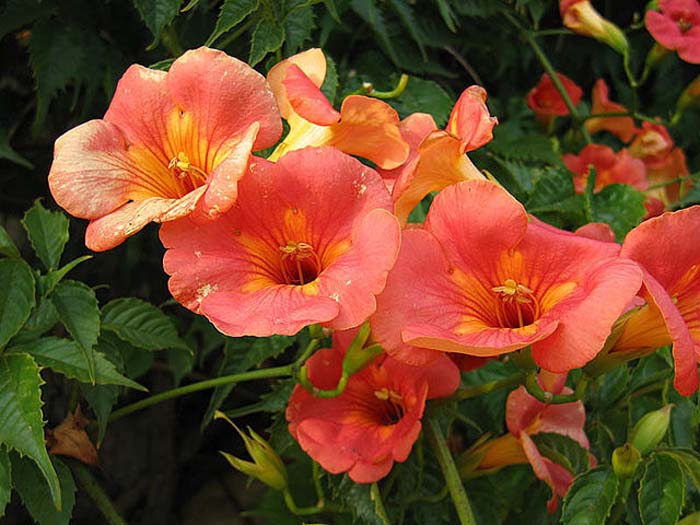Planting for wildlife!
Published 4:46 pm Monday, May 1, 2023

- ATTRACTING WILDLIFE: Campsis Grandiflora or Trumpet vine is great for attracting hummingbirds.
“Can words describe the fragrance of the very breath of spring?” – Neltje Blanchan.
“A flower blossoms for its own joy.”- Oscar Wilde.
“My favorite weather is bird chirping weather.” – Terri Guillemets.
“No matter how chaotic it is, wildflowers will still spring up in the middle of nowhere.” – Sheryl Crow.
“The earth laughs in flowers.” – Ralph Waldo Emerson.
“An optimist is the human personification of spring.” – Susan J. Bissonette.
“When all at once I saw a crowd, A host, of golden daffodils; Beside the lake, beneath the trees, Fluttering and dancing in the breeze.” – William Wordsworth.
“The spring wakes us, nurtures us and revitalizes us. How often does your spring come? If you are a prisoner of the calendar, it comes once a year. If you are creating authentic power, it comes frequently, or very frequently.”- Gary Zukav.
April has left until next year and May is here! Take a break and spend some time in the great outdoors to enjoy what nature brings to your doorstep. Nature offers such a diverse theatre of plants, animals and elements within each community. Naturally, live music and movies are created by nature each day through every living creature in your own backyard. In planning your wildlife landscape, add color and movements with distinct sounds that make your home landscape appear more alive and vibrant in your quest to welcome birds and butterflies into your space. Thus, the arrival of birds, butterflies and other forms of wildlife to your home grounds is an indication that nature approves and accepts your involvement in the grand scheme of things.
Among nature’s tenants are songbirds in the shade trees and bird feeders, hummingbirds and bees on the flowers, butterflies in the air, and squirrels and rabbits on the lawn and in the beds. Also, occasionally a rabbit, deer, fox or opossum might wander across your grounds. Furthermore, seeing mockingbirds playfully fighting in flight, watching the bluejays tangle with the redwing blackbirds, observing an eagle and a hawk fighting over the same prize in mid-air, and viewing black snakes and poisonous snakes doing battle, nature offers so very much more. Many sights and sounds provide surprise, entertainment and enjoyment as nature sets the stage through music and movies in a way that takes us into the daily lives of all these living creatures.
Although all gardens naturally attract some forms of wildlife, you can encourage a greater volume and variety of activity by planting specific trees, shrubs, and flowers. In return for your visual, hearing, and emotional gratifications, you provide them with food and shelter. A small number of selectively chosen plants will appeal to a wide range of nature’s inhabitants.
A wildlife garden should be located near your observation point from the front porch, back deck, sitting garden, or through a window for ease of enjoyment. However, any expanse of glass reflecting vegetation is likely to deceive birds by becoming a crash site and injuring the welcomed guests. Prevent this potentially dangerous occurrence by placing chimes or other decorative items near the window, or designing patterns on the glass that would minimize such crashes.
The key to landscaping for wildlife is plant groups or clusters rather than individual plants. A single tree or shrub is rarely sufficient screen to be adequate cover for wildlife. The better microenvironment to attract wildlife includes a combination of trees, shrubs, groundcovers, flowers, ornamental grasses and lawns with a careful selection of birdhouses, bird feeders and bird baths placed strategically throughout the site. As you sit quietly in or on your observation base, be sure to have a set of binoculars, a camera and access to the internet. The world of nature will quickly unfold before your eyes as her stage gives you the opportunity for a moment of complete gratification as you document such an awesome display of natural talent.
As we choose plants for seasonal color throughout the year, we are also providing food and shelter for our wildlife over the same time span. Choose flowers that will provide nectar-feeders with food during each season, and plants that flower at different times. Whether you are aware of it or not, your landscape already houses several insects and seed-bearing plants. Just think of the thousands of seeds developed from one crabgrass plant. This scenario provides food sources for most wildlife creatures, especially birds.
Some trees and shrubs that are favorite food sources for birds are flowering crabapple, Oregon grape holly, pyracantha, and chokeberry. Sunflowers are a favorite in seed production.
Bird preferences for nesting purposes include Japanese hollies, cotoneaster, junipers, Japanese barberry, Washington hawthorn, pyracantha and honeysuckle. Birds need exposed perching places with dead twigs and small snags being most beneficial. Hummingbirds eat insects such as aphids, but also need large amounts of nectar to meet their high energy requirements (thus hummingbird feeders are a plus). They respond best to red, orange and pink flowers that are tubular in shape. Their long tongue is adapted to penetrate and pollinate blossoms like trumpet vine and fuchsia. Hummingbirds are very belligerent and territorial. Thus, grow flowers in several locations throughout the property. Popular annuals for sunny sites include salvia, zinnias, snapdragons, and sweet william. Perennials for sunny sites include bee balm, penstemon, butterfly weed and red hot poker. In partial shade include columbine, bleeding heart or coral bells.
Plantings for butterflies include butterfly weed, butterfly bush, mock orange, lilac, weigela, and button bush. Perennial flowers for a butterfly garden include phlox, coreopsis, rudbeckia, verbena, lantana, and catnip. Annuals include alyssum, asters and sunflowers. Although butterflies are attracted to tubular, nectar-bearing flowers, they also need flat flowers where they can rest. A good variety of flowers, shrubs, and trees will provide plenty of resting sites.
Attracting squirrels, chipmunks, raccoons, rabbits, deer and other animals to your landscape can create both pleasure and torment. While interesting to watch, they may be destructive. You make the choice based on your own preferences and priorities.
You may supplement your plantings with shelters and feeders. From bird houses, gourds, and feeder units to bird baths, these structures will be used by your new neighbors, the wild friends. In the world of wildlife, news travels fast. Thus, plants and flowers and beyond can be beneficial to humans and creatures alike.
As you plan and develop your wildlife landscape, it will become filled with various species of birds, butterflies and small animals within a few seasons. It will become a true sanctuary from which your new wildlife neighbors will provide you with hours of enjoyment through watching, listening, and learning. Always take the time to hear the birds singing in the trees, as well as the bird singing in your soul. “A cardinal is a representative of a loved one who has passed. When you see one, it means they are visiting you. Look for them, they’ll appear.” Unknown. Please keep our upcoming mission trip to Peru uplifted in prayer for gospel effectiveness, safety, and eternal love. Happy Cinco de Mayo!
“But you, O God, do see trouble and grief; You consider it to take it in hand. The victim commits himself to You; You are the helper of the fatherless.” Psalm 10:14. “If anyone considers himself religious and yet does not keep a tight rein on his tongue, he deceives himself and his religion is worthless. Religion that God our Father accepts as pure and faultless is this: to look after orphans and widows in their distress and to keep oneself from being polluted by the world.” James 1:26-27. “Arise, LORD! Lift up Your hand, O God. Do not forget the helpless.” Psalm 10:12. “And my God will meet all your needs according to His glorious riches in Christ Jesus.” Philippians 4:19.





